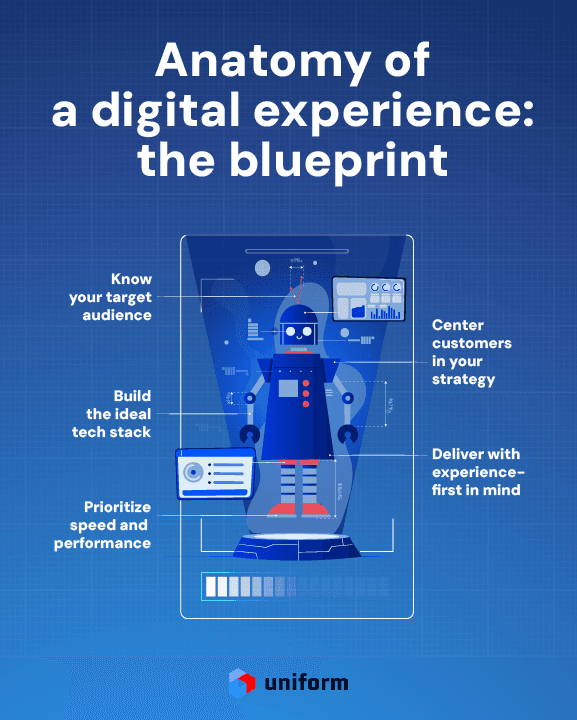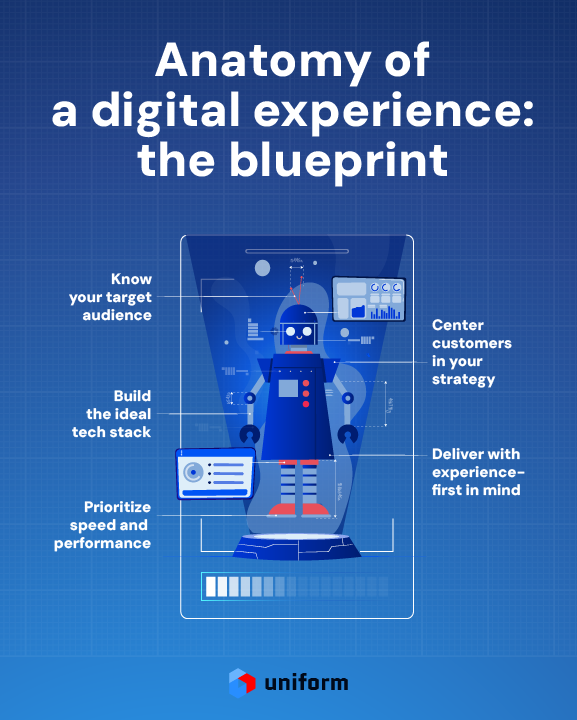Uniform blog/Anatomy of a digital experience: the blueprint
Anatomy of a digital experience: the blueprint
Anatomy of a digital experience: the blueprint
Customers are no longer satisfied with subpar digital experiences that fail to put their needs and interests first. In a world where 86 percent of buyers will pay more for an amazing experience, laying the groundwork for omnichannel success is critical to winning and retaining customer loyalty.
However, launching a digital experience that delights audiences and drives business requires strategic planning and serious investment in the right tools, platforms, and workflows that power your campaigns.
In part one of our series, we share 5 key elements of the blueprint for delivering incredible omnichannel experiences that level your team up and elevate your brand.

Know your target audience
Scott Cook, billionaire and cofounder of Intuit, once said, “Instead of focusing on the competition, focus on the customer.”
Never has this been truer than in today’s shifting landscape. Print and radio ads, TV commercials, and billboards aren’t enough to attract and retain buyers. Cultivating trust and connecting with audiences happens through personalized experiences that address their problems with tailored solutions.
Your customer experience strategy should start and end with the people who purchase and champion your services and products. Buyer personas, behavioral analysis, and segmentation are go-to tactics that provide valuable insight into your customers’ background, and their motivations and incentives to purchase from your brand. However, if you lack the budget and tools to understand your target audience better, knowing how to use that data to personalize experiences can pose even bigger challenges.
As you kick off the planning phase of your customer experience strategy, your technology will serve as a testing ground to determine which areas of your campaign resonate with site visitors.
Build the ideal tech stack
In years past, your primary option for content delivery was a one-size-fits-all content management system (CMS) that handled most, if not all, of the digital production process. Despite their limitations—chief among them, inflexible front-end interfaces and costly upgrades—traditional CMSs continue to dominate the market.
With the rise of mobile internet use and omnichannel communications, newer technologies such as headless CMSs offer an alternative for building modern, immersive experiences that can help you scale up in the future and evolve with your tech stack. And with a front-end experience solution such as a visual workspace, you can further capitalize on the strengths of traditional and headless CMSs, reaping several benefits:
- You avoid the pain and high cost of replatforming, which often takes months or even years to complete.
- You lay a solid framework for integrating marketer-first capabilities, such as generative AI and A/B testing, while reducing the custom code required to build experiences.
- You drive a culture that enables your brand to test, adapt, and implement elements of your experience that work—and to quickly remove the components that do not.
As you plan your digital experience, make sure your tech stack sits on top of a solution that allows you to keep your existing CMS, try new platforms, and choose best-of-breed tools that fit your unique requirements.
Prioritize speed and performance
When laying the blueprint for your digital experience, site design matters. That said, site performance is paramount to delivering an experience that boosts online traffic and converts leads.
Page speed or load speed impacts SEO and is the make-or-break point between an effortless user experience and a poor one. Though personalization is integral to delivering relevant content, how quickly site visitors find and navigate your brand experience across channels also affects your rank on search engine results pages.
Before building webpages, consult your business and technical teams to ensure your stakeholders are on board with prioritizing the speed and usability of your customer experience. Digital teams must understand the resources needed to optimize your site for search engines, user experience, and lead conversion, as well as how to expand and adapt your capabilities without overhauling your entire tech ecosystem.
Center customers in your strategy
Unlike multichannel, which is product-centric and focuses primarily on web and mobile marketing, omnichannel is customer-centric and connects your audiences wherever they are, regardless of platform or medium, online or off. Yet, many brands fall short of delivering a truly omnichannel experience:
- Owning omnichannel requires not only a deep knowledge of customer preferences but also an alignment of internal workflows and systems, as well as the unification of enterprise-wide content, data, and technologies.
- In omnichannel, content elements such as text length and image resolution impact how and where you repurpose content across your experience. For example, a website landing page won’t automatically translate to a mobile app or email communication.
Planning for these variables is crucial when adopting a customer-centric approach in your omnichannel experience management process. Working in a visual workspace that unifies the full range of customer data in one place can facilitate your content creation process, enabling you to build content for any channel and from any source.
Deliver with experience-first in mind
Before the rise of omnichannel, CMSs anchored digital experiences that were largely web-centric and independent from other channels. While this content-first approach, dictated mainly by traditional CMSs, allowed marketers to create content, they had little control over how or where content was incorporated into their enterprise applications.
Anchoring your tech stack around your CMS, and, thus, your content, is a sure path to sustainable omnichannel failure. Rather, by adopting an experience-first approach–a focus on building the most targeted, engaging experiences, and then creating supportive content–you see a more equal distribution of content ownership, organizational resources, and tools between developers and marketers. This shift in focus to the customer, and with each member performing with the least amount of friction, empowers digital teams to launch experiences that meet fast-changing customer expectations and ever-increasing sales targets.
Map out a digital experience that delights customers
Evaluating which tools, technologies, and resources you need to deliver lightning-fast experiences, and adopting the best fits for your organization, will create alignment within the overall your digital team, processes, and systems to accelerate customer engagement with your brand. The Uniform Visual Workspace can play an important role in this planning phase, freeing you to safely create and experiment with the full range of your content in a single, powerful interface.
In the second part of our series, learn about the different elements and components that comprise a stellar digital experience.






.png&w=1080&q=90)
.png&w=1080&q=90)
.png&w=1080&q=90)